Introduction
Almarai Company is the leading producer of dairy in Saudi Arabia. It deals with dairy farms and produces processed foods, markets all its farm products and fruit juices. It’s a well-established company in the Middle East and wishes to group itself in the Middle East region and to grow its markets to other countries. In February, this year, it announced a partnership with a well-known company called PepsiCo, which is the leading drinks company in the world. This is a good indicator that Almarai is the best company in the Middle East and a fast-growing company. This partnership is in a bid to expand to all other regions in the Middle East, Africa, and Southeast Asia. The name for the new partnership is International Dairy and Juice, of which PepsiCo’s share is 52% and that of Almarai is 48% (Krugman and Wells 145).
Almarai has announced its multimillion-dollar investment for its expansion. This plant will start its operations within the next one and half years of its investment and sell its food products. Almarai Company was incorporated in 1976 by Alastair McGuckian and Paddy, in joint venture with Prince Sultan Mohammed bin Saudi Al Kabeer. It is being managed by the HH Prince Sultan bin Mohammed bin Saudi Al Kabeer who has explored all options in techniques to be used in production from the traditional to the modern methods which will necessitate meeting demands of the fast-growing market in Saudi Arabia and the whole world.
Almarai engages its subsidiaries in various processes from production, distribution, to marketing of all its products throughout the Middle East and other parts of the world. Its main products include poultry, Arable and Horticulture, Bakery, Dairy and Juice. The company uses the Almarai as its own identification name in all the products it produces and sells across the region.
The financial crisis in general
The financial crisis is due to poor corporate governance and the executive remuneration which is mismatched. The financial crisis in general is affected by the major financial institutions which do not show their trading procedures, financial instruments, and the position of the balance sheet.
There is the problem of weak rules that oversee the operation of all trading instruments, and the financial conglomerates. Lack of effective capital regulation and improper application of accounting rules contributes greatly to risk-taking by the banks. The rating agencies at times are not under the watch of the national regulator.
There is also the distrust among the financial market key players. This leads to the breakdown of the temporary transactions in the financial sector which will greatly bring about the market economies and meltdown in the exchanges securities worldwide. When the interbank lending and the money markets are frozen, there is no capital that will be directed to other economic intermediaries in the production sequence.
The government and the monetary institutions should put in place policies that regulate the performance of the financial institutions so that cases of financial crisis will not occur again. Confidence in the company will be re-ignited in the financial system. Recapitalizing financial intermediaries should be done by either injecting capital directly or through the processes of mergers and acquisitions.
There should be active coordination being implemented so as to reduce the occurrence of the cross-border contagion effects. The financial crisis will be able to be resolved within the shortest time possible in the financial market so as to restore the short-term lending. Macroeconomic and microeconomic policies will also be used in restoring the adverse effects of the crisis. In this case the central banks will have to lower their rates to uplift the falling price levels.
Motivation about the topic
Financial services are the main factors that are used in determining the company’s performance. It’s the main reason why companies’ names are reflected through the financial services. This topic gives an in-depth analysis of the functions of the company. It also measures the economic performance of the world at large. It’s therefore, motivating to study it as we are all beneficiaries of the study. We are all investors in one way or another hence having knowledge of how companies operate is very crucial. Being an investor, will guide us on what to invest in and the company to invest in as well. The situation here is that the company, investors, and the students benefit a lot. This is a topic that in itself gives us more ideas on calculations and analysis. It enlightens us in a very special way. The company also under study captures most of my attention as it’s the main company which deals with the dairy and juices in the world with its main consumers being domestic i.e. the Middle East.
Almarai is a company that is respected in the Middle East. It has played major roles in assisting or contributing to the society at large through employment opportunities, provision of services, establishing social amenities, educational sector where it has sponsored many needy students besides building schools, and participation in social activities like organizing and sponsoring athletics in the region. This company motivates me as I would like to offer them advice based on their operations so that they can deliver the best in the market and that the company will rip a lot of benefits. Almarai has been participating in helping the less fortunate families through its charitable programmed department. It is an ISO-certified company in all the departments it operates.
Almarai Company has been able to overcome all the challenges it underwent all through the years since its establishment. Their capital base is of great importance as it has enabled them to sustain themselves in all the economic storms which have been experienced throughout the world.
There are a lot of factors that have led to this. First is its technology which has enabled it to produce quality foods and juice. This makes its products be the most proffered in the market by the customers. Customer satisfaction is the key to success in such an industry of Almarai Company. The management of the company is competent. This is seen through the strategies in place in the company and the policies made on the day to day basis. This has ensured that the services delivered by all the employees are of the standard desirable to the company and to its esteemed customers. The competent management also has ensured that the junior employees are competent which translates to quality products in the end. The methods and the formulas used in production especially with the foods and the juice are the best. No company can compete with Almarai since its production process is unique. This uniqueness makes the company’s products be the only choice of the customers. This is quite desirable in the food industry as tastes and preferences are the only way out. Hence the company needs to operate in such a manner that the tastes that people get are of its own kind (Lasher 206).
The company is the best in the market world over and this means that the topic is motivating in exploring the company’s locations, functions, profitability, stock markets operations in the leading stock market in the Middle East and among the competitors of the big three stock exchanges in the world. It’s admirable and challenging to carry on with such a task which is in detail of the company’s operations more so the computations involved which are good sources in the mind building. The topic of financial crisis affects every person legal or the individual. Being one of them, I also have an inner motivation in finding out the various ratios and interpretation of the company’s financial position. This can be translated to personal life and the economic situations which surround us and how we benefit from established companies such as Almarai Company.
It enables one to assess the company’s performance so as to get an inner understanding of upcoming position of the company and be able to adjust to it accordingly. Hence there is satisfaction derived from the analysis of the financial position of the company to a far much wider perspective. Being informed is the main task hence the motivation derived is overwhelming on the international financial crisis of the Almarai Company. This is the best topic to work on as I benefit and also learn more on what goes on, on the companies around us.
Positive effects of the financial crisis
There are positive effects of the financial crisis on Almarai Company. Scientists have said that there is nothing like absolute truth, but given a financial crisis, the company will realize that there is nothing like free market. Hence this tells us that truth is a relative concept. Freedom is another concept that is relative hence a company’s market freedom is always relative. Almarai just like other companies across the world have always been looking for ways of overcoming financial crisis except for the philosophical contradictions. Almarai has tried its best as a single entity and on a collective perspective to overcome the financial crisis that has covered the whole world in order to minimize the losses due from it.
There are some positive effects of the financial crisis to Almarai despite the financial crisis in the whole world. One of the positive effects is the fall of the ever dominating business giants in the market and brings in the international relations which are refreshed as this has been the main cause of the crisis. This will enable all other companies to start all over again at the same level and build their own name again in the market so as to establish a renewed relationship with the customers.
Almarai Company will be able to establish a new bond with the customers who are beneficial to its performance and gain a great market share. Since there are a lot more companies that have fallen due to the financial crisis, the Almarai Company will take the advantage and establish itself in those regions by gaining a lot of customers. For example Wall Street which dominated the world investments from all over the world in investment fell over the financial crisis; hence Almarai uses the opportunity to seek investors of Wall Street who were avoiding it. This will bring about an investment shift to the Almarai Company and other companies which have not been dominating the world market; hence the world financial system will be stabilized. This shift is very vital as it restructures the relationships between countries or the companies on local and international levels.
The other effect is that there will be changes being made on the rules and regulations of the financial system market through the global bodies like the International Monetary Fund, World Trade Organization and World Bank among others. The rules that have been in use after the second world war were only applicable at that time but since currently there are other new economic powers on the international level, they do not fit the globalization age of the world today. Almarai Company has been utilizing its reserves as other companies were struggling to survive hence making it be seen as the most stable company in the region and the whole world (Mankiw 46).
The other effect is that the financial crisis will bring a lot of other investment opportunities as this will be changed simply because other new upcoming companies will be seen to be offering assurance and investment opportunities to the world funds. This will be in agreement or at per with the WTO when restructuring relationships on the commercial sectors which will enhance specialized production per country. In this case Almarai will benefit from it as it’s the leading producer of its products in the Middle East and the neighboring countries besides on the International level.
The other benefit is that all the financial and the banking system at the time of financial crisis are always regulated and monitored closely by their regulating authorities. This involves controlling the financial institutions, making them be transparent on their activities and being subjected to global financial governance.
Finally, financial crisis would lead to the elimination of the big financial institutions on the stock markets that have ever been occupying the top positions in the world. This will enhance a new distribution system by enabling Almarai to take over the market domination in the global financial and economic operations. When experiencing this financial crisis, it’s the best time for Almarai to evaluate its performance and service delivery. This will enable the company to arrive at a conclusion on the best way to operate or the best strategies to utilize. Almarai Company has drawn a lot of conclusions related to this financial crisis and the losses that have been experienced by other countries and companies. This simply means Almarai is using the negative situations of other companies to develop itself on the market share, stable financial activities, and win the investors’ confidence.
Negative effects of the financial crisis
The negative effects of the financial crisis on Almarai Company are there and within the range of control by the company. Almarai is a food processing industry will be greatly affected by the financial crisis. First, the purchasing power of the customers will be reduced. This will mean that most of its products will not be bought by their customers at the same rate or quantity. People are always sensitive to the changes in the financial market as they are also affected. Consumers of Almarai are also involved in the generation of the income to the country either by being employed or on their own businesses. Hence when their sources of income are affected, then their spending will definitely be affected.
The liquidity of Almarai Company is affected by the financial crisis. Liquidity is the ease of buying or selling an asset by the company without the price of the asset being affected or changed in any way. Almarai Company is the company at the center stage of all the details especially at the stock market. Its shares are not being well traded in the market due to this financial issue. The company’s assets when the company wants to dispose of them are not easy for them to do so. This is because the assets’ set price or disposable price would be seen as high at this particular time not unless the company is willing to dispose of it at lesser value.
Trading activities at the stock exchange market are also greatly affected. The company faces a lot of problems in winning the investors’ confidence to invest in their stocks. This is as a result of fear of the unknown just in case the stock exchanges collapse due to the adverse effects of the financial crisis. The stock exchanges are the most feared investments as it is greatly affected by small changes in the financial scene. The Almarai Company is the leading food and juices processing company in Middle East can easily be affected by the financial problems. This will greatly affect the well-established name of the company both locally and on the international scene.
Financial analysis of the company
The financial crisis is in quarters three and four in the year 2008 in Almarai Company as indicated in the ratio analysis below. The financial analysis of Almarai Company is important in determining the financial position of the company. This is used to know the liquidity of the company, profitability and efficiency of the company. These ratios really help to assess the company’s worth before undertaking any investments. The ratios are beneficial to the company and the external users.
The ratios are used by the company management in projecting its future prospects and investments. This will guide the company on their performance as compared to other companies in the same or different industries. The external users also will use the ratios to predict the companies’ worth in investing in it. These will enable them have confidence in the company’s management and hope for a good return in future (Horne and Wachowicz 89).
Profitability ratios
Summary table
Quarter four ratio analysis summary 2009
Gross profit margin = Gross profit / Sales * 100
= 568606 / 1,548,167 * 100
=36.73%
Net profit margin = Net profit / sales * 100
= 248,818 / 1,548,167 * 100
= 16.71%
Return on assets = Net profit/ Total Assets* 100
= 248,818 / 10,986,995 * 100
= 2.26%
Return on Equity = Net profit/ Shareholders Equity*100
= 248,818 / 5,382,635 * 100
= 4.62%
Quarter three ratio analysis summary 2009
Gross profit margin = Gross profit / Sales * 100
= 697627 / 1547440 * 100
= 45.1 %
Net profit margin = Net profit / sales * 100
= 363434 / 1547440 * 100
= 23.5%
Return on assets = Net profit/ Total Assets* 100
= 363434 / 9565782 * 100
= 3.8%
Return on Equity = Net profit/ Shareholders Equity*100
= 363434 / 4144569 * 100
= 8.77 %
Quarter two ratio analysis for 2009
Gross profit margin = 591,314 / 1,447,118 * 100
= 40.86%
Net profit margin = 287,099 / 1,447,118 * 100
= 19.83%
Return on assets = 287,099 / 8,880,823 * 100
= 3.27%
Return on Equity = 287,099 / 3,831,357 * 100
= 7.49%
Quarter one ratio analysis for 2009
Gross profit margin = Gross profit / Sales * 100
= 508245 / 1326080 * 100
= 38.32%
Net profit margin = Net profit / sales * 100
= 197371 / 1326080 * 100
= 14.88%
Return on assets = Net profit/ Total Assets* 100
= 197371 / 8767336 * 100
= 2.4%
Return on Equity = Net profit/ Shareholders Equity*100
= 197371 / 3415718 * 100
= 5.78%
Ratio analysis for quarter three 2008
Gross profit margin = Gross profit / Sales * 100
= 572859 / 1388534 * 100
= 41.3%
Net profit margin = Net profit / sales * 100
= 293676 / 1388534 * 100
= 21.14%
Return on assets = Net profit/ Total Assets* 100
= 293676 / 8136120 * 100
= 3.6%
Return on Equity = Net profit/ Shareholders Equity*100
= 293676 / 3734497 * 100
= 7.86 %
Ratio analysis for quarter two 2008
Gross profit margin = Gross profit / Sales
= 514527 / 1247520*100
= 41.24%
Net profit margin = Net profit / sales * 100
= 235232 / 1247520 * 100
= 18.9 %
Return on Assets = Net profit/ Total Assets* 100
= 235232 / 7852576*100
= 3.0%
Return on Equity = Net profit/ Shareholders Equity*100
= 235232 / 3702805 * 100
= 6.35%
Ratio analysis for quarter one 2008
Gross profit margin = 416259 / 1119066 * 100
= 37.2%
Net profit margin = 162195 / 1119066 * 100
= 14.5%
Return on assets = 162195 / 7289577 * 100
= 2.25%
Return on equity = 162195 / 3268368 * 100
= 4.96%
Ratio analysis for quarter four 2007
Gross profit margin = 393976 / 1044773 * 100
= 37.71 %
Net profit margin = 193083 / 1044773 * 100
= 18.48%
Return on assets = 162195 / 6335830 * 100
= 2.56%
Return on equity = 162195 / 3053446 * 100
= 5.32%
Ratio analysis for quarter three 2007
Gross profit margin = 416509 / 1012390 * 100
= 41.14%
Net profit margin = 186067 / 1012390 * 100
= 20.5%
Return on assets = 186067 / 5907277 * 100
= 3.15 %
Return on equity = 186067 / 2869458 * 100
= 6.48 %
Gross profit margin explanations
Gross profit margin indicates the company’s profitability before factoring in the expenses. Generally, the company is experiencing an increase in its gross profit margin in the three successive years. The financial crisis has not affected the operations of the company on the sales and its costs. This shows that the company is in a position to maintain its functions even when it’s under any financial crisis. Almarai maintained its own operations through the tough economic moments experienced in the world. The graphical representation is shown below.
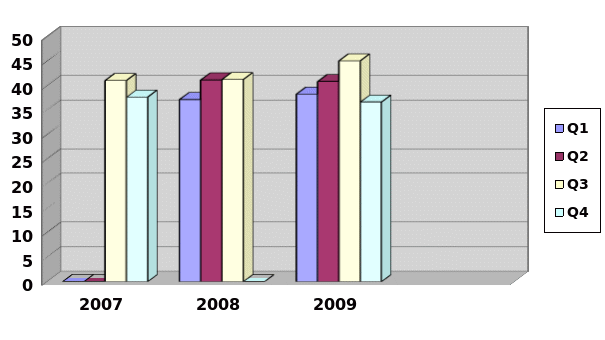
Net profit margin explanations
Net profit margin measures the profitability of the company after all the costs of producing have been deducted. The company has been experiencing an upward trend all through the seasons in the three years but in the year 2008; it shows a decline in the net profit margin. This is the time the financial crisis was experienced in the Arabian region. Prior to and after the financial crisis, the company was experiencing an upward trend in its performance.
In this situation of Almarai Company, the Net profit margin has been increasing steadily over the three years. This indicates that the company is carrying out its functions effectively as indicated by the profitability margin. Shareholders will use this information in deciding on what and how much should be invested in the company of such performance. Almarai is therefore indicated as a well-managed company and is utilizing well the available resources (Moyer and McGuigan 124). The graphical representation is shown below.
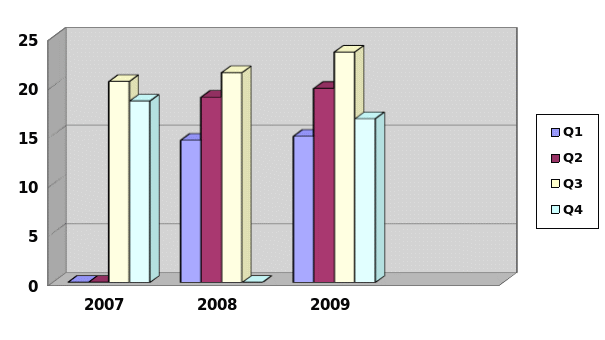
Return on Assets (ROA)
This measures actual profitability of the company when it’s compared to the assets it has. The company has experienced a decline in the return on assets in the fourth and first quarters of the 2007 and 2008 respectively. The company shows an increase in its performance in the third and second quarters in the year 2008. This shows that the company was affected by the financial crisis in the year 2008.
In the analysis for the three years, it’s fluctuating. In the year 2009, the ROA is lower than the earlier two years hence the profitability of the company compared to total assets is less. The net profits have been increasing and the assets as well. This means that the company is acquiring more assets at higher rate (Correia and Flynn 205). The graphical representation is shown below.
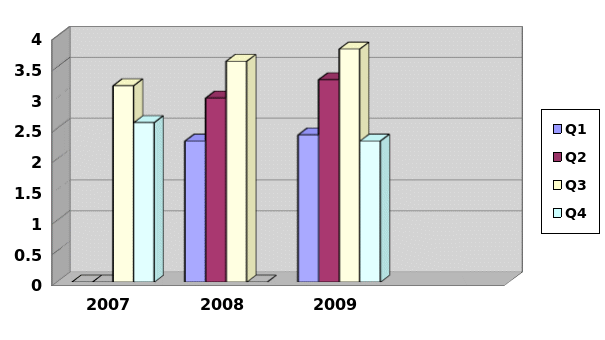
Return on Equity
This is used by the company to establish the shareholders’ earnings in relation to the equity of the shareholders. This indicates how the company is performing. This also is used to tell the shareholders how effective their investment in the company is. This is useful information to the shareholders in identifying the effective use of their investment to the effect of their management. The company experienced a decline of the return in shareholders equity in the first quarter of the year 2008 which indicated 4.96%. The graph below, shows the representations of ROE on the graph.
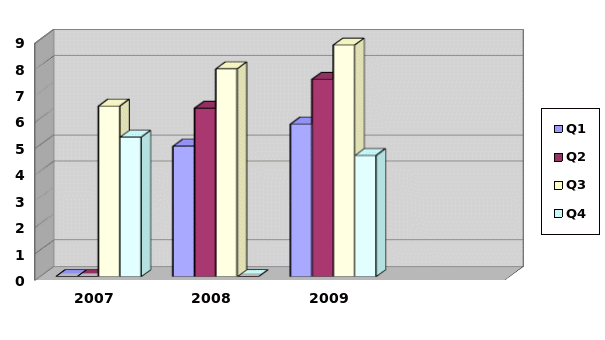
The company also is showing an upward trend throughout the year of 2008. This could be the time when the company is recovering from the financial crisis and at the same time the investors have made a lot of investments in the company especially the year 2009 though there is an increase in the net profits. The figure itself is not an indication of the performance of the company but its interpretation is important.
Summary of the liquidity ratios
Quarter four ratios calculations for the year 2009
Leverage ratio = Debt to Equity Ratio = Total Liabilities / Owners Equity or Net Worth
=5604360 / 5,382,635
= 1.04
Current ratio = Curent Assets / Curent Liabilities
= 2181733 / 1,440,272
= 1.5
Working capital = Current Assets – Current Liabilities
= 2181733 – 1,440,272
= 741461
Quick ratio = (Current assets- Inventory) / Total liabilities * 100
= 963,158 / 5604360 * 100
= 17.18%
Quarter three ratio calculations for the year 2009
Debt to Equity Ratio = Total Liabilities / Owners Equity or Net Worth
=5421213 / 4144569
=1.31
Current ratio = Current assets / current liabilities
= 1991144 / 1,467,039
= 1.36
Working capital = Current assets – Current liabilities
= 1991144 – 1,467,039
= 524105
Quick ratio = (Current assets- Inventory) / Total liabilities * 100
= 852,967 / 5421213 *100
= 15.73%
Quarter two ratio calculations for the year 2009
Leverage ratio = Debt to Equity Ratio = Total Liabilities / Owners Equity or Net Worth
= 5049466 / 3831357
= 1.31
Current ratio = Curent Assets / Curent liabilities
=1883609 / 1,499,710
= 1.26
Working capital = Current assets – Current liabilities
= 1883609 – 1,499,710
= 383,899
Quick ratio = (Current assets- Inventory) / Total liabilities * 100
= 807,469 / 5049466 * 100
= 16%
Quarter one ratio calculations for the year 2009
Leverage ratio = Debt to Equity Ratio = Total Liabilities / Owners Equity or Net Worth
=5337852 / 3415718
= 1.56
Curent ratio = Curent Assets / Curent Labilités
= 1754399 / 1548277
= 1.13
Working capital = Current assets – Current liabilities
= 1754399 – 1548277
= 206122
Quick ratio = (Current assets- Inventory) / Total liabilities * 100
= 667173 / 5351618 * 100
= 12.45%
Quarter two ratio calculations for the year 2008
Leverage ratio = Debt to Equity Ratio = Total Liabilities / Owners Equity or Net Worth
= 4149771 / 3702805
= 1.12
Current ratio = Current Assets / Current Liabilities
= 1637791 / 1101183
= 1.49
Working capital = Current assets – Current liabilities
= 1637791 – 1101183
= 536608
Quick ratio = (Current assets- Inventory) / Total liabilities * 100
= 690355 / 4149771 * 100
= 16.63%
Quarter one ratio calculations for the year 2008
Leverage ratio = Debt to Equity Ratio = Total Liabilities / Owners Equity or Net Worth
= 4020189 / 3269368
= 1.23
Current ratio = Current Assets / Current liabilities
= 1719971/ 979168
= 1.75
Working capital = Current assets – Current liabilities
= 1637791 – 1101183
= 536608
Quick ratio = (Current assets- Inventory) / Total liabilities * 100
= 690355 / 4149771 * 100
= 16.63%
Quarter four ratio calculations for the year 2007
Leverage ratio = Debt to Equity Ratio = Total Liabilities / Owners Equity or Net Worth
= 3282384 / 3053446
= 1.07
Current ratio = Current assets / current liabilities
=1274988 / 767718
= 1.66
Working capital = Current assets – Current liabilities
= 1274988 – 767718
= 507270
Quick ratio = (Current assets- Inventory) / Total liabilities * 100
= 541415 / 3053446 * 100
= 17.73 %
Quarter three ratio calculations for the year 2007
Leverage ratio = Debt to Equity Ratio = Total Liabilities / Owners Equity or Net Worth
= 3037819 / 2869458
= 1.06
Current ratio = Current assets / current liabilities
= 1008898 / 640358
=1.57
Working capital = Current assets – Current liabilities
= 1008898 – 640358
=368540
Quick ratio = (Current assets- Inventory) / Total liabilities * 100
= (1008898 – 588701) / 3037713 * 100
=420197 / 3037713 * 100
=13.83%
Leverage ratio / Debt to equity ratio analysis
This is the ratio that is used by companies to establish their own financial performance position. This ratio is looked at from the perspective of the debt and the owner’s equity. The debts are those borrowings which the company takes to fund its activities or to expand the functions of the company. This is beneficial to both the company and to the external users such as the shareholders, creditors, and the new investor.
This ratio tells the shareholder how well his/her equity has been used in the company. This ratio enables the shareholders to determine the actions which need to be taken especially on the quality and efficiency of the company management. The creditors will be able to establish whether the company is in a position to meet their debt within a short period of time as per their demands. The graphical representation is shown below.
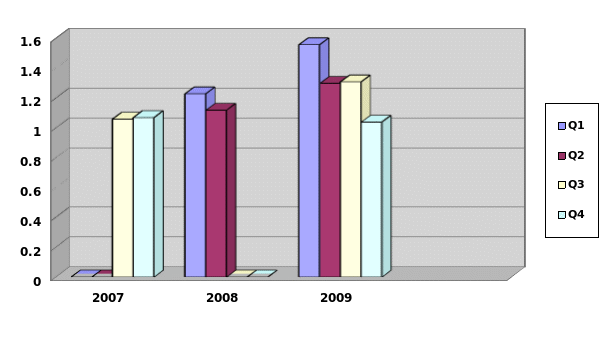
They will be able to predict the company’s capabilities and when to be able to give them a credit and to what extend. The ratio enhances the accountability to the shareholders and all the stakeholders on the use of their money. This accountability is what determines the ability of the company to repay the money they are owed without affecting the shareholders’ equity. It’s the management of the shareholders’ equity that enables the company to access more financial strength.
In Almarai Company, the ratio has been well and changing with respect to the performance of the economy such that when there is an economic crisis, the company performance was put to test. In the 2008 crisis, there was a positive effect on the performance of the company. The company was not affected greatly hence the reasons why there was a normal performance in the company. In this issue, the company has been stable and increased its financial debt meaning that the company is still seen to be at its best of performance.
The management of Almarai is competent employees who have ensured that the performance of the company meets the expectations of all the stakeholders. This ratio may not be a clear representation of the companies’ performance compared to other companies in the industry. This is because the accounting techniques used are different and do not require the same interpretations.
Current ratio
This ratio indicates the company’s performance and its capacity to meet its immediate needs in cash. The ratio also shows the effectiveness of the company to handle the immediate assets and liabilities. The ratio is very important to all the stakeholders especially those who are interested in the short-term relationship.
When the ratio is below one, then the company does not have enough money to meet the short-term demands. When the ratio is above, it shows that the company’s liquidity is enough to settle all the short-term liabilities. The ratio will enable also the stakeholders like the creditor to know how the company is going to settle their demands in the short run. This ratio ensures that the company’s performance is as expected and enables the management to keep watch of all the functions it takes in the short run. The graphical representation is shown below.
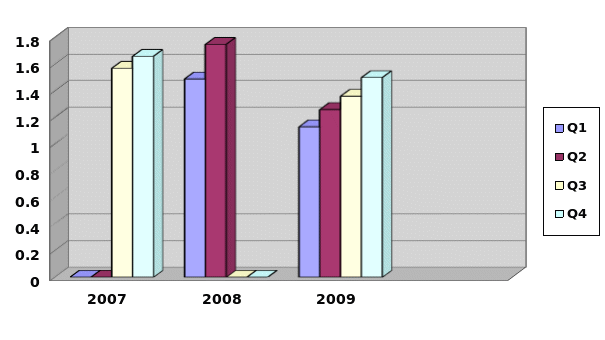
In Almarai Company, the ratio shows that the company is managing its short-term liabilities well for in the year 2007 and in early 2008 in quarter two; there was a sharp decline from 1.75 to 1.49 in quarter two. It further declined to 1.13 in quarter three when there was economic crisis. This shows that any changes in the economy really affect the performance of the company especially on its short-term performance as it deals with the cash, inventories, short-term loans, debtors among others. In early 2009, as shown in quarter one; there was improvement all the way to the fourth quarter of the year. This indicates that the company can bring back its performance to the normalcy within a very short time and be able to recover what had been lost before.
Working capital
This is used to determine also the company’s abilities to settle the short-term liabilities. Positive figure shows that the company has enough t meet the short-term obligation of its liabilities. This is very important to the company considering that there is borrowed money to finance the operations of the company. Borrowings in the company are very important and they ensure that the company does not operate due to lack of finance. The graphical representation is shown below.
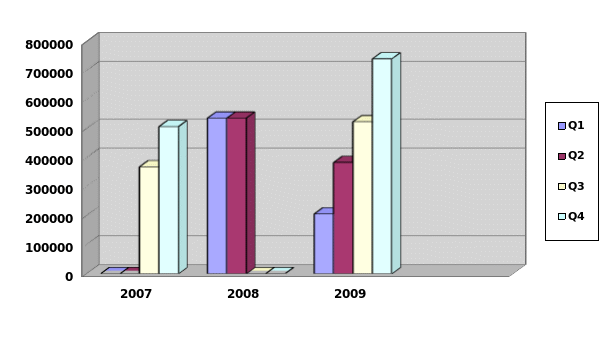
The company also is capable of using the short-term liabilities to meet the immediately pressing needs especially the daily operations. The working capital is very important as it ensures that the company’s cash worth is in stable control and that the issues related to bankruptcy are minimal. Almarai Company has shown a positive working capital showing that the company is capable of meeting the immediate obligations. The company is performing well as compared to other industries which most of which almost were declared bankrupt.
Quick ratio
This ratio measures the company’s ability of the company’s assets to be transformed to cash form. This measure how quickly is the company settle down the immediate obligations by quickly converting the current assets into cash so as to pay off the immediately pressing issue. The inventories are eliminated from the calculation of the ratio. The graphical representation is shown below.
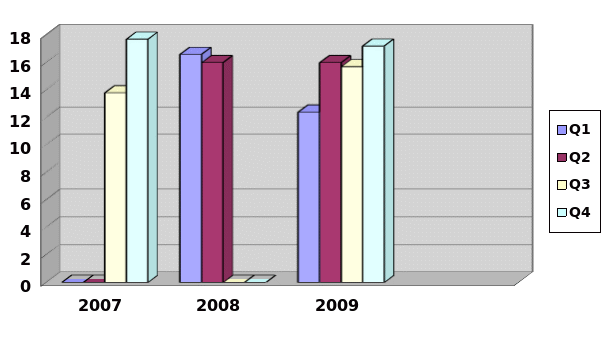
The company is able to pre-determine their creditworthiness before accepting any loans which need to be paid within a very short period of time, roughly within a year or six months. The ratio ensures that the company and the creditors are well taken care of. The company will be able to involve itself in operations that bring in much return within a very short time which are capable of settling the liabilities at hand.
The company can also access the loan facilities from any financial institution which ensures that the transactions are within their capability. In Almarai Company, the ratio is quite good and encourages the management and shareholders on the quality management of the company. The company is the best in responding to the economic issues and it has well-established plans which will enable the company to tackle well the various economic challenges that may occur in the country or the world hence it cannot be not to be caught unawares of the crisis.
This ratio enhances the comparison of companies in all sectors or within one sector. There is a limitation of different procedures being employed in different companies or industry which may make it impossible to ascertain the true and exact value of the company’s performance.
The ratios are very important in predicting the form of investment the company should be involved in. The company will be able to establish its sources of expansion depending on the rate of its earnings and the risk involved in the execution of such operations. Almarai Company is a well-established company which is recognized all over the world and thus its expansion is done within a very short notice. The investor confidence is totally enhanced and thus its access to finance is within reach.
The company over the financial crisis was not heavily shaken as its expansion was not affected at all. The investors of the company still kept the money flowing in and the operations were not affected. The company also had access to the credit facilities in the region which necessitated the company to function normally. Over the crisis, the company was not affected so much. It was hit by the crisis but it was within the level which the company could manage. The losses were not much but expansion was the way out for the company to enhance its liquidity.
This enabled the company to execute its operations without much loss being expected in the economy hence there were no job losses by its employees. The company there was affected positively by the economic crisis in the region. The company used the negative effects of the crisis and maximized on it to attain a maximum output as it was expected in the country by the stakeholders. The company also had to establish its name well in many regions which had not been tapped over the period of the crisis. Much of the company expansion was done over this period which shows that the management was using the negative effects to strengthen its functions and increase the revenue. This is a good strategy in balancing the problems being faced with those which are affecting the economy. The company management is made up of very competent employees who are very efficient and handle risks as per the situation and cautiousness of the unforeseeable issues of great economic value or effects.
The management also is the one who has established a strong bond between the employees and the customers. The bond has further been extended to the financial institutions and to the investors hence the activities of the company are not shaken by any circumstances. This is the only way the company had to survive the crisis which was experienced in the region and the entire world. The crisis is of great effects if companies are not well prepared to overcome such challenges. The economic crisis is one of the worst effects on the operations of the companies and hence the management has to be well equipped with enough skills and techniques to absorb such challenges.
Conclusion
In conclusion, the company is running its activities well and is still gaining more Markey in the industry throughout the world. It is the leading company in the world in delivering its services to the people. It has a well-established management team and utilizes the latest technology in the market. Its joint venture with PepsiCo is a plus to the company as it will expand its market share and the innovations used in the production process. PepsiCo is a respectable company also in the whole world hence Almarai will also develop and improve its services even when there is a financial problem (Brigham and Ehrhardt 201).
The technique used in analyzing the company’s performance is not the only one and does vary from company to company or in an industry. The company also may be using various accounting techniques which may result in differences in coming up with uniform applications. Almarai Company was not heavily shaken by the financial crisis that occurred in the global economy.
This can be seen in its excellent performance throughout the period. There was growth still in the company’s sales volume. The profits also went up. This is a clear indication to the shareholders that the company can withstand all the financial storms that may hit the whole world or the Middle East. This implies that the strategies of Almarai are the best and will enable it to grow even beyond the expectations of the shareholders (Atrill 25).
Works cited
Atrill, Peter. Financial Management for Decision Makers. New Jersey: Financial Times/Prentice Hall, 2008.
Brigham, Eugene, and Michael Ehrhardt. Financial management: theory and practice. New York: Cengage Learning, 2008.
Brigham, Eugene, and Philip Daves. Intermediate Financial Management. New York: Cengage Learning, 2010.
Correia, Carlos, and David Flynn. Financial Management. Pretoria: Juta and Company Ltd, 2007.
Horne, James, and John Wachowicz. Fundamentals of Financial Management. New Jersey: Prentice Hall, 2008.
Krugman, Paul, and Robin Wells. Macroeconomics. New York: Worth Publishers, 2009.
Lasher, William. Practical Financial Management. New York: Cengage Learning, 2007.
Mankiw, Gregory. Principles of Macroeconomics. New York: Cengage Learning, 2008.
Moyer, Charles, and James McGuigan. Contemporary Financial Management. New
York: Cengage Learning, 2009.
Tracy, Tage, and Andrews John. Small Business Financial Management Kit for Dummies. New Jersey: For Dummies, 2007.
